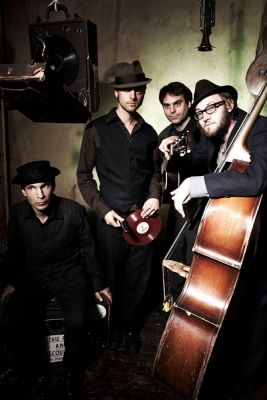The Wiyos have traveled a very long distance, both geographically and figuratively, during their five-year lifespan. There are the statistics - they have driven over 400,000 miles in seven different countries and played over 1,000 shows; but there is also the creative journey, which has been just as epic and equally adventurous.
Many musicians throughout history have made their coin leading the life of wandering troubadours, and The Wiyos have definitively embraced and embodied this tradition. They began life as an acoustic trio in a tavern on the lower east side of Manhattan during the summer of 2002 (a neighborhood historically known as the 'Five Points' district). An old street gang from that area, The Why'os, became the band's namesake, and soon thereafter on their inaugural tour to New Orleans, the band put down their hats and plied their trade. Originally meant to be a few days stopover in the Crescent City, their van broke down and they stayed for two weeks, becoming enchanted with the city, meeting many new musicians and beginning the process of steeping themselves in the early swing era.
The Wiyos' first recording project was an exploration of the new songwriting collaboration between Michael Farkas and Parrish Ellis. They enlisted the help of Joe Dejarnette as recording engineer and producer and soon he was also busy fulfilling the upright bass duties. The trio experimented in the studio with multi-tracked instrumental layers and manipulating acoustic tonalities, with occasional use of unusual items (a comb, megaphone, ceramic cup) to produce unique sonic effects. This eclectic debut album, entitledPorcupine, made sense for a group of music geeks (two being music school dropouts) with omnivorous and expansive musical tastes ranging from early jazz to hip-hop, country blues to classic rock, New Orleans brass bands to Appalachian stringbands, The Beatles to Beck and Tom Waits.
Around the time of the first record, they began to devote themselves intensely to the study of the spectrum of traditional American musical idioms that were recorded from circa 1900 through the 1930's.
As a result of this newborn fascination with old-timey American music, they began performing more country blues, ragtime and western swing songs in their concerts and decided to make their next recording project a document of their high-energy stage shows. Teaming up with engineer/producer Perry Margouleff, the band recorded their second and third records at PIE studios, which is equipped with some of the world's best vintage analog gear. In an anomaly from the contemporary methods of recording, both records were cut entirely live over the course of a few days. Using only three microphones and a reel of two-track analog tape, they recorded live with no overdubs, multi-tracking or digital editing. Due to their years of dedication to being a well-rehearsed touring ensemble, almost all the songs were captured on the first take.
Both the second album Hat Trick and the most recent The Wiyos derive inspiration from the great dance bands and houseparty music of 80-90 years ago; the early swing syncopations, the grit and intensity of rural blues, the bouncing rhythms of piedmont fingerpickers, the vocal antics, mannerisms and physical comedy of vaudeville-era performers. The difference inherent in The Wiyos is the notable proliferation of songs written by Farkas and Ellis, the results being some very interesting and singular original music. Their songs exist in multiple styles and eras simultaneously without sounding forced or affected.
At present The Wiyos are in transition from a trio to a quartet, with new addition Teddy Weber adding multifaceted songwriting, singing, steel slide and acoustic guitar (and occasional alto horn) to the fold. This expanded creative collaboration coupled with the inevitable maturation into new stylistic fusions and sound-scapes is laying the framework for the fourth full-length album, release date TBA.

